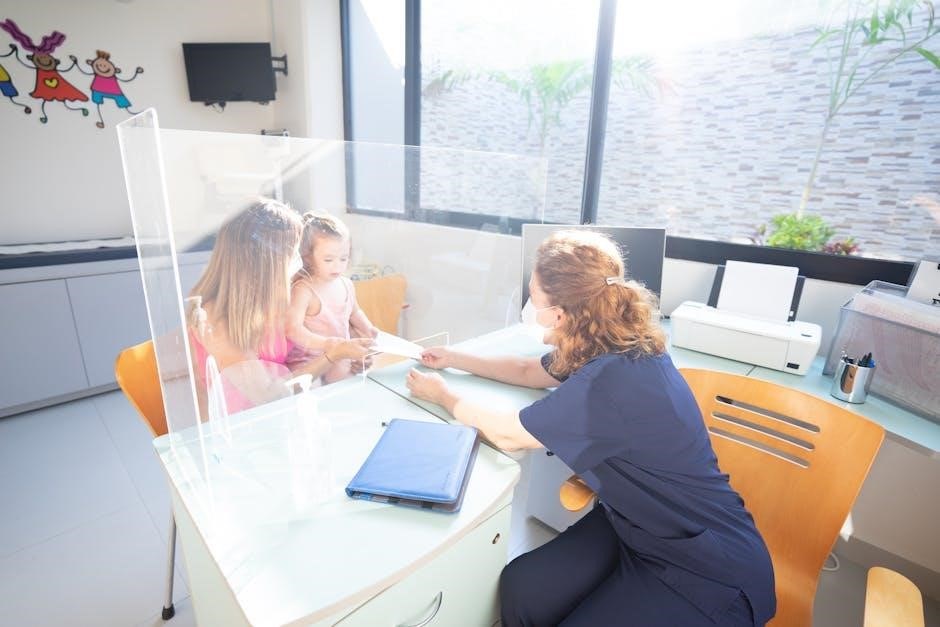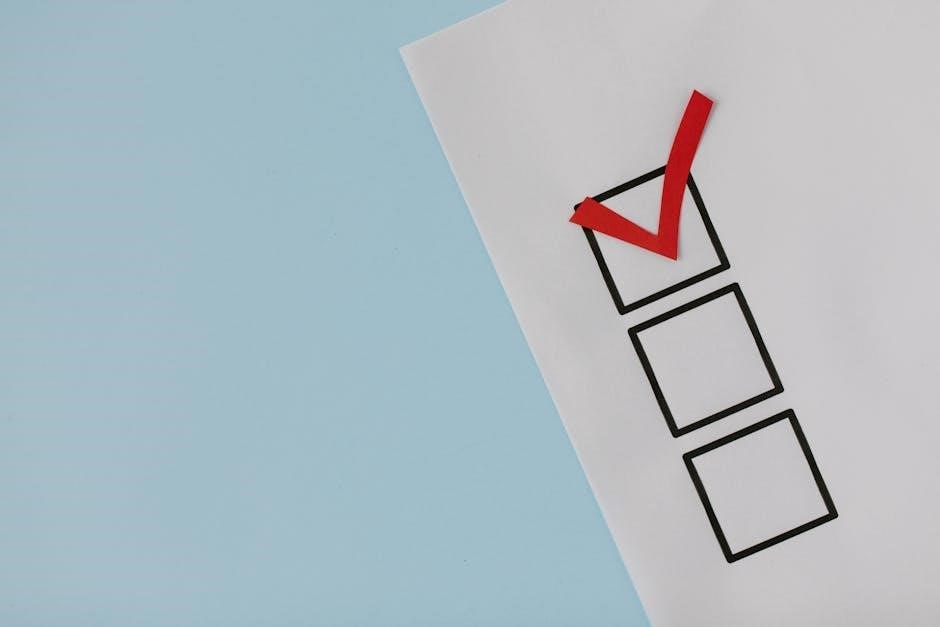Cranial nerve assessment is a systematic evaluation of the 12 pairs of nerves originating from the brain stem‚ essential for diagnosing neurological conditions and ensuring optimal patient care.
1.1 Overview of Cranial Nerves
The 12 pairs of cranial nerves originate from the brain stem and control a wide range of essential functions‚ including sensory input‚ motor responses‚ and parasympathetic activities. Their assessment is crucial for diagnosing neurological conditions‚ as abnormalities often indicate specific pathologies in the brain stem or along their pathways. This evaluation helps identify issues related to nerve damage‚ stroke‚ or other neurological disorders‚ impacting daily body functions and overall health.
1.2 Importance of Cranial Nerve Assessment
Cranial nerve assessment is crucial for diagnosing neurological conditions‚ as it provides insights into the functional integrity of the brain stem and peripheral nerves. Early detection of abnormalities can guide timely interventions‚ improving patient outcomes. It also aids in monitoring recovery and adjusting treatment plans‚ making it a cornerstone of neurological and musculoskeletal care‚ ensuring accurate diagnosis and effective management of complex conditions.

Anatomy of Cranial Nerves
The 12 cranial nerves originate in the brain stem‚ each with unique pathways and functions‚ playing vital roles in controlling sensory and motor activities of the body.
2.1 Structure and Function
Cranial nerves are composed of sensory‚ motor‚ or mixed fibers‚ each serving distinct roles. Their intricate pathways connect the brain to peripheral structures‚ enabling functions like vision‚ hearing‚ and facial movements. Proper assessment ensures identification of abnormalities‚ guiding diagnosis and treatment of neurological conditions effectively.
2.2 Origin and Pathways
Cranial nerves originate from specific nuclei in the brain stem‚ with each nerve following distinct pathways to innervate target structures. Their precise routes‚ from the brain to peripheral tissues‚ are crucial for diagnosing lesions or damage. Understanding these pathways aids in localizing neurological deficits‚ ensuring accurate assessment and effective patient care.

Clinical Significance of Cranial Nerve Assessment
Cranial nerve assessment is vital for diagnosing neurological conditions‚ such as nerve damage‚ stroke‚ and brain stem pathologies‚ ensuring accurate diagnoses and effective patient care strategies.
3.1 Role in Diagnosing Neurological Conditions
Cranial nerve assessment plays a critical role in diagnosing neurological conditions by identifying abnormalities in nerve function‚ such as vision loss‚ hearing impairment‚ or facial weakness. These findings help localize lesions or damage in specific brain regions‚ guiding further diagnostic testing and treatment plans. Accurate assessment enables early detection of conditions like stroke‚ multiple sclerosis‚ or nerve compression‚ improving patient outcomes through timely intervention.

3.2 Indications for Cranial Nerve Testing
Cranial nerve testing is indicated in patients with symptoms like vision loss‚ hearing impairment‚ facial weakness‚ or speech difficulties. It is also essential in traumatic brain injuries‚ strokes‚ multiple sclerosis‚ or suspected nerve compression. Testing is warranted in conditions affecting brainstem function or during preoperative assessments for surgeries involving cranial nerves. Early detection of abnormalities ensures timely intervention and improves patient outcomes.
Examination Techniques for Cranial Nerves
Examination involves systematic assessment of each cranial nerve’s function‚ including inspection‚ palpation‚ and specific tests like visual field testing and reflex evaluation to identify abnormalities.
4.1 Screening Neurological Examination
A screening neurological exam evaluates cranial nerve function through visual field tests‚ pupillary reflexes‚ eye movements‚ hearing assessments‚ and facial strength; It helps identify abnormalities by comparing bilateral responses‚ ensuring early detection of potential neurological issues‚ guiding further detailed assessments if needed.
4.2 Step-by-Step Assessment of Each Cranial Nerve
A step-by-step assessment involves evaluating each of the 12 cranial nerves individually. Tests include olfactory nerve (smell)‚ optic nerve (vision)‚ oculomotor and trochlear (eye movements)‚ trigeminal (facial sensation and motor)‚ facial (muscle strength)‚ vestibulocochlear (hearing)‚ glossopharyngeal (swallowing)‚ and hypoglossal (tongue movement). Each assessment uses specific techniques to gauge nerve function‚ ensuring a systematic and thorough evaluation of neurological status.
Specialized Tools and Resources
Cranial nerve assessment often utilizes charts‚ video guides‚ and mnemonic aids. These tools provide structured frameworks and visual demonstrations‚ enhancing accuracy and efficiency in nerve function evaluation.
5.1 Cranial Nerve Examination Charts
Cranial nerve examination charts are essential tools that provide a clear‚ organized method for assessing nerve function. These charts often include visual diagrams‚ functional assessments‚ and checklists‚ ensuring a systematic evaluation of all 12 cranial nerves. They serve as quick references for healthcare professionals‚ enhancing accuracy and efficiency during examinations. Many charts also include mnemonics and anatomical illustrations to aid in understanding nerve pathways and functions.
5.2 Video Demonstrations and Guides
Video demonstrations and guides provide a visual and interactive way to learn cranial nerve assessment techniques. These resources offer step-by-step instructions‚ practical examples‚ and real-time observations‚ enhancing understanding and proficiency. They are particularly useful for training healthcare professionals‚ ensuring accurate and effective nerve function evaluations. Such tools are invaluable for both educational and clinical settings‚ aiding in the mastery of cranial nerve examination skills.

Common Pathologies and Abnormal Findings
Common pathologies include strokes‚ tumors‚ and nerve damage‚ often presenting with facial weakness‚ diplopia‚ or vision loss. Early detection of these abnormalities is critical for timely intervention.
6.1 Recognizing Abnormal Signs
Abnormal signs in cranial nerve assessment may include facial weakness‚ diplopia‚ vision loss‚ hearing loss‚ or speech difficulties. These signs often indicate underlying pathologies such as nerve damage‚ strokes‚ or tumors. Early identification of these abnormalities is crucial for timely intervention and preventing further complications. Clinicians must carefully observe and document any deviations from normal function during the examination process.
6.2 Case Studies and Examples
Case studies highlight real-life applications of cranial nerve assessment. For instance‚ a patient with unilateral facial weakness may indicate a stroke affecting cranial nerve VII. Another example includes a patient with anosmia (loss of smell) due to head trauma‚ involving cranial nerve I. These examples demonstrate how abnormal signs guide accurate diagnoses and targeted interventions‚ emphasizing the clinical relevance of thorough assessments.
Nursing Perspective on Cranial Nerve Assessment
Nurses play a vital role in cranial nerve assessments‚ ensuring accurate documentation and patient preparation. They utilize mnemonics and standardized tools to perform thorough‚ safe evaluations.
7.1 Role of Nurses in Cranial Nerve Examination
Nurses are integral in conducting cranial nerve examinations‚ assessing visual fields‚ pupillary reflex‚ eye movements‚ hearing‚ and facial strength. They utilize mnemonics to remember nerve functions and ensure patient safety. Nurses also document findings accurately‚ preparing patients and maintaining asepsis. Their role is crucial for early detection of abnormalities and guiding further interventions.
7.2 Safety Guidelines and Best Practices
Adherence to safety guidelines is crucial during cranial nerve assessment. Nurses should use personal protective equipment‚ ensure proper patient positioning‚ and maintain infection control protocols. Handling of equipment must follow safety standards‚ and MRI safety guidelines should be strictly observed to prevent accidents. Regular training and updates ensure competency‚ promoting a safe and effective examination environment.
Rehabilitation and Cranial Nerve Function
Rehabilitation plays a vital role in restoring cranial nerve function‚ focusing on recovery and adaptation. Frequent reevaluation ensures targeted interventions‚ optimizing recovery and improving patient outcomes effectively.
8.1 Importance of Frequent Reevaluation
Frequent reevaluation is crucial in rehabilitation to monitor cranial nerve function progress and adapt treatment plans. Regular assessments ensure interventions remain effective‚ addressing changes in nerve recovery or decline. This approach allows for timely adjustments‚ optimizing outcomes and improving patient quality of life. Consistent monitoring also helps identify potential complications early‚ ensuring comprehensive and targeted care.
8.2 Optimizing Rehabilitation Outcomes
Optimizing rehabilitation outcomes involves tailored interventions based on frequent cranial nerve assessments. Targeted therapies‚ such as speech or physical therapy‚ enhance recovery by addressing specific deficits. Incorporating patient-centered goals ensures personalized care‚ improving functional abilities and quality of life. Regular feedback and adjustments to treatment plans are essential for achieving maximal recovery and long-term success in rehabilitation.
OSCE Guide for Cranial Nerve Examination
The OSCE guide provides a structured approach to cranial nerve assessment‚ including step-by-step techniques and video resources‚ ensuring competence in clinical examinations and patient evaluation.
9.1 Step-by-Step OSCE Approach
The OSCE approach involves a systematic evaluation of each cranial nerve‚ starting with patient history and progressing through specific tests for each nerve. Examiners assess visual fields‚ eye movements‚ facial strength‚ hearing‚ and reflexes‚ comparing bilateral responses to identify abnormalities. This method ensures a thorough and efficient examination‚ preparing candidates for real-world clinical scenarios effectively.
9.2 Tips for Successful Examination
Approach the examination with confidence and a structured plan. Use cranial nerve charts for quick reference and practice regularly to improve efficiency. Focus on comparing bilateral responses and recognizing abnormal signs early. Familiarize yourself with mnemonics for nerve functions. Stay calm‚ follow a logical sequence‚ and be prepared for specific instructions from examiners to ensure a smooth assessment process.

Mnemonics and Memory Aids
Mnemonics are essential tools for memorizing cranial nerve names and functions. Techniques like “On Old Olympus’ Towering Top” help recall nerve order. These aids simplify complex information and enhance retention for students and professionals‚ making cranial nerve assessment more accessible and efficient in clinical practice and education.
10.1 Mnemonics for Cranial Nerve Names and Functions
Mnemonics like “On Old Olympus’ Towering Top‚ A Finn And German Viewed Some Hops” help remember cranial nerve names. Each word corresponds to a nerve‚ aiding in recall. Such tools simplify learning‚ especially for students‚ ensuring quick and accurate identification of nerves during assessments. These memory aids enhance retention and reduce errors in clinical settings‚ making them invaluable for professionals and learners alike.
10.2 Practical Applications of Mnemonics
Mnemonics are invaluable in clinical and educational settings‚ aiding quick recall of cranial nerve functions during assessments. They simplify complex information‚ reducing errors in diagnosis and treatment plans. Nurses and students use these tools to enhance memory retention‚ ensuring accurate and efficient evaluations. Mnemonics also facilitate teaching‚ making cranial nerve assessment more accessible and practical for learners at all levels.
Emerging Trends in Cranial Nerve Assessment
Emerging trends include the integration of advanced imaging and AI-driven diagnostics‚ enhancing precision in cranial nerve evaluation and improving early detection of neurological disorders.
11.1 Advances in Diagnostic Techniques
Recent advancements in diagnostic techniques include the use of high-resolution MRI‚ diffusion tensor imaging‚ and AI-driven algorithms to enhance the precision of cranial nerve assessments. These tools enable earlier detection of abnormalities and improve the accuracy of diagnosing conditions like nerve compression or brainstem pathologies. Additionally‚ portable devices and telemedicine platforms are expanding access to neurological evaluations globally.
11.2 Integration of Technology in Assessment
Technology integration has revolutionized cranial nerve assessment‚ offering digital tools like mobile apps‚ video guides‚ and AI-powered software. These innovations enhance accuracy‚ streamline documentation‚ and provide real-time feedback. Virtual reality is also being explored for immersive training‚ ensuring clinicians master assessment techniques. Such advancements not only improve diagnostic efficiency but also standardize care‚ making cranial nerve evaluations more accessible and reliable worldwide.
Cranial nerve assessment remains vital in neurology‚ with future directions focusing on integrating advanced technologies like AI and telemedicine to enhance diagnostic accuracy and accessibility.
12.1 Summary of Key Points
Cranial nerves are essential for various bodily functions‚ and their assessment is crucial for diagnosing neurological conditions. Accurate examinations‚ using tools like charts and video guides‚ help identify abnormalities. Nurses play a key role in these assessments‚ ensuring patient safety and best practices. Regular reevaluation and rehabilitation are vital for optimal outcomes. Emerging trends‚ including technology integration‚ promise to enhance future assessments and improve diagnostic precision.
12.2 Future Directions in Cranial Nerve Assessment
Future advancements in cranial nerve assessment may include improved diagnostic imaging‚ AI-driven analysis‚ and wearable devices for continuous monitoring. Enhanced tools and standardized protocols will likely emerge‚ offering greater precision. Integration of technology into nursing education and clinical practice will further elevate the accuracy and accessibility of cranial nerve evaluations‚ benefiting both patients and healthcare providers.
